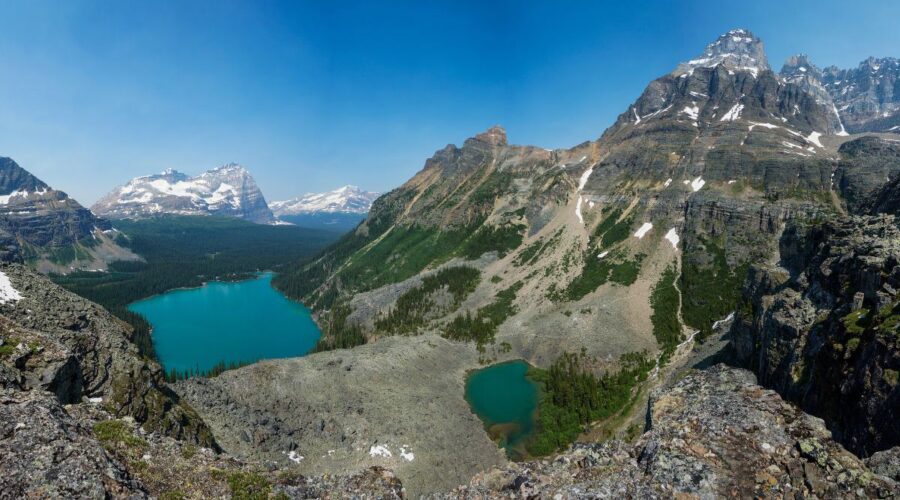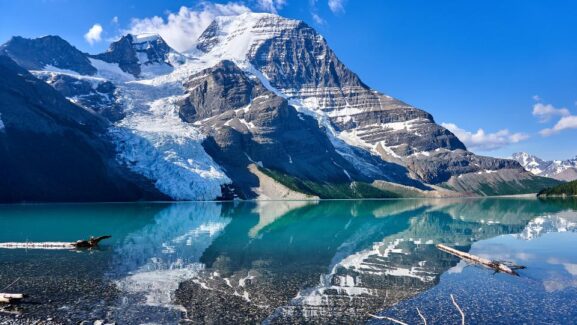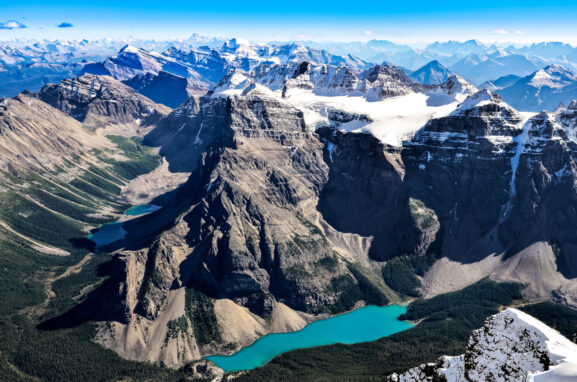The 10 Best Hikes At Lake O’Hara In Yoho National Park
Lake O’Hara is one of those rare places in the world that feels untouched and wild. Across the Contiental Divide from Lake Louise, here you have everything the Canadian Rockies are world famous for: crystal-clear lakes, jagged peaks and alpine meadows stretching in every direction.
With no crowds so you can mindfully unplug and just enjoy the awe and beauty of this magical place that experienced hikers travel from all over the world to check off the hiking bucket list.
You will find Lake O’Hara inside Yoho National Park in British Columbia, just west of Lake Louise and about an hour’s drive from Banff. This area is as close as you’ll get to a sacred place in the Canadian Rockies, so access is limited to keep it wild.
You can’t just drive to the lake. There are only 4 ways to get to Lake O’Hara:
1. Parks Canada Shuttle
This is the easiest option. The shuttle operates from June 20th to October 5th, 2025. Reservations are required, but you need to win a spot in a lottery-style reservation system (you must apply in March).
Typically, Parks Canada receives over 20,000 applications for just 3,000 day-use seats available each summer so many people try for years without any luck.
2. Hike The Access Road
If you don’t get a shuttle seat, you can hike the 11 km (6.8 miles) road. It’s a steady uphill climb with about 500 meters of elevation gain. No special permit required, just a lot of stamina.
I generally only recommend this option if you have a reservation at one of the campgrounds or alpine cabins, which are also very difficult to get. Once you get to Lake O’Hara, there’s just so much to see, and the hike into the lake takes up close to half your day.
3. Hire A Hiking Guide
Some licensed hiking guides and local tour operators have a small number of reserved shuttle spots to get to Lake O’Hara. Booking with them may give you access, even if you missed the lottery.
Since there are such limited spaces on the shuttle buses, you need to book early with a local hiking tour operator (go here to book a Lake O’Hara hiking guide) and most tour companies don’t do Lake O’Hara because of the difficulty booking with Parks Canada.
4. Lake O’Hara Campground
If you can’t secure a shuttle reservation or a spot at Lake O’Hara Lodge, camping at the Lake O’Hara Campground is an excellent alternative.
This backcountry-style campground offers a more immersive experience in the alpine environment. It is open from June 20th to October 5th each year. Reservations open each year for a single day in late January through the Parks Canada Reservation Service.
5. Stay At Lake O’Hara Lodge
If you have to splurge, you can stay at the Lake O’Hara Lodge. which offers accommodations from mid-June to early October. It’s not cheap but it includes transportation to the Lake O’Hara.
Here are the rates for the Lake O’Hara Lodge in 2025:
Main Lodge Rooms: $990 per night for two guests
Lakeshore Cabins: $1,400 per night for two guests
Cedar Cabins: $1,400 per night for two guests
Rates include meals, afternoon tea, round-trip transportation on the lodge’s private bus, and all taxes and gratuities. A minimum stay of three nights is required.
Keep in mind that Lake O’Hara Lodge fills up, so it’s a good idea to book at least 1 year in advance because the limited spots fill up here too.
Once you’re up at Lake O’Hara, it’s all trailheads, turquoise lakes and jaw-dropping views. No roads, no cars, no cell service… just you and the mountains.
If it’s your first time or you want to explore the high routes safely, a hiking guide is a smart choice. They’ll handle the navigation, help you identify local flora, fauna and fungi while also sharing insider knowledge that brings the place to life.
With a bit of planning, Lake O’Hara becomes more than a bucket list hike… it will probably become one of your favourite hiking memories and peak experiences of your life.
1. Lake O’Hara Shoreline Trail
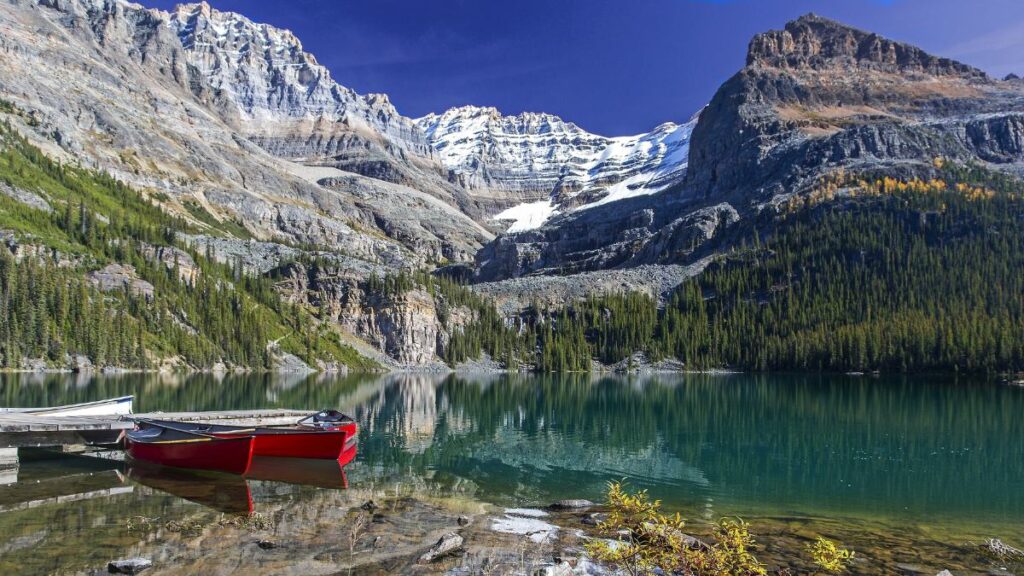
Distance: 2.9 km (1.8 miles) loop
Elevation Gain: 13 m (43 ft)
Time: 1 hour
Difficulty: Easy
This peaceful loop hugs the shore of Lake O’Hara and is a great intro to the area’s beauty. The trail is wide, mostly flat and gives you uninterrupted views of emerald waters framed by dramatic mountain backdrops.
You’ll pass waterfalls, cross footbridges, and see reflections of Mount Schaffer and Wiwaxy Peaks shimmering in the lake. Wildlife sightings here are common, so keep an eye out for pikas and Clark’s nutcrackers.
It’s accessible, family-friendly, and a great way to start your Lake O’Hara visit. Grab a coffee at the Lake O’Hara Lodge and enjoy a sunrise lap, or unwind here at the end of a long hiking day.
2. Lake Oesa Trail
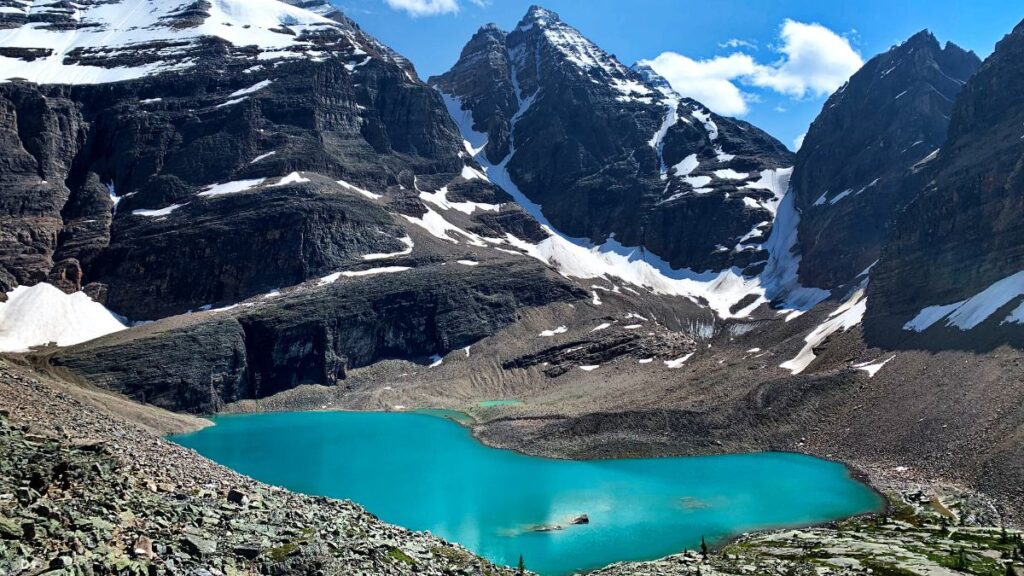
Distance: 6.6 km (4.1 miles) return
Elevation Gain: 240 m (787 ft)
Time: 2 to 3 hours
Difficulty: Moderate
Starting from Lake O’Hara, this hiking trail climbs steadily through talus slopes and alpine forest to the aquamarine waters of Lake Oesa. Along the way, you’ll pass a string of small turquoise pools and the cascading waters of Victoria Falls.
The climb is rocky but well-marked, with stone steps carved into the slope. It’s a perfect mix of effort and reward, and the scenery gets more dramatic with each switchback.
Lake Oesa is tucked into a high alpine bowl surrounded by jagged peaks. Pack a snack and enjoy the silence and stillness here. This spot is pure mountain magic.
3. Opabin Plateau Circuit
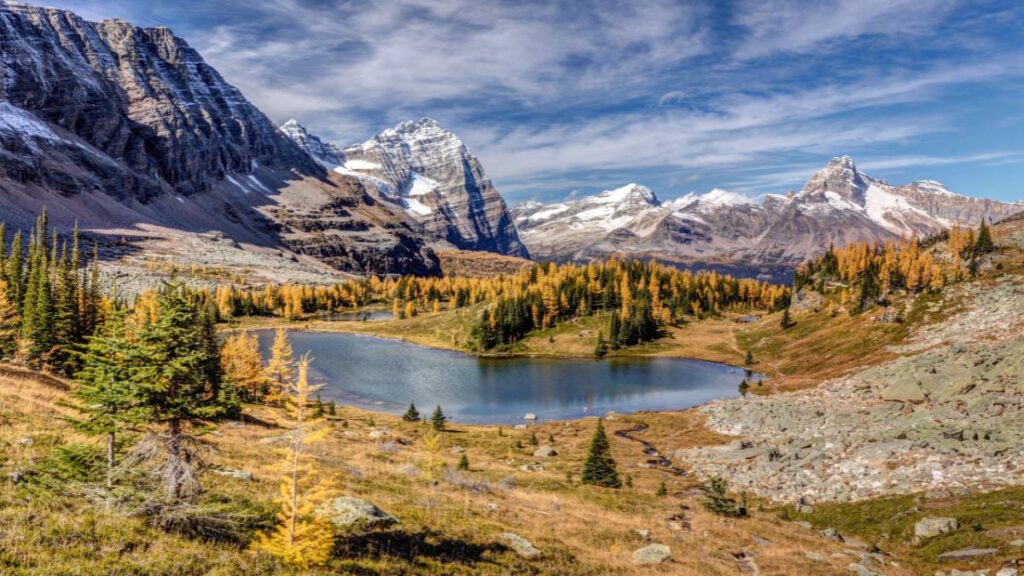
Distance: 5.9 km (3.7 miles) loop
Elevation Gain: 250 m (820 ft)
Time: 2.5 to 3 hours
Difficulty: Moderate
This loop climbs to the Opabin Plateau, a stunning high-elevation meadow filled with tarns, wildflowers, and larches. You can hike it clockwise or counter-clockwise, but either way the views are a knockout.
From Opabin Prospect, you get the iconic postcard view of Lake O’Hara, Mary Lake, and the full sweep of the valley below. It’s one of the best photography spots in the Rockies.
The hiking trail is well-maintained but has a few steeper sections and exposed ledges. In fall, the golden larches light the place up in a spectacle that happens every year from mid-September to early October.
4. Lake McArthur via McArthur Pass

Distance: 8 km (5 miles) loop
Elevation Gain: 310 m (1,017 ft)
Time: 2.5 to 3.5 hours
Difficulty: Moderate
This quieter trail starts near the Le Relais shelter and winds through larch forest and meadows to one of the bluest lakes in the Rockies. McArthur is deep, dramatic, and flanked by cliffs and glaciers.
You can take the longer, more scenic Big Larches trail or the shorter forested route. Either way, it’s a steady climb with huge visual payoff at the lake.
This is a great mid-day hike if you want solitude and glacier views. Bring lunch and hang by the lakeshore—it’s one of the most peaceful spots in the area.
5. Alpine Circuit
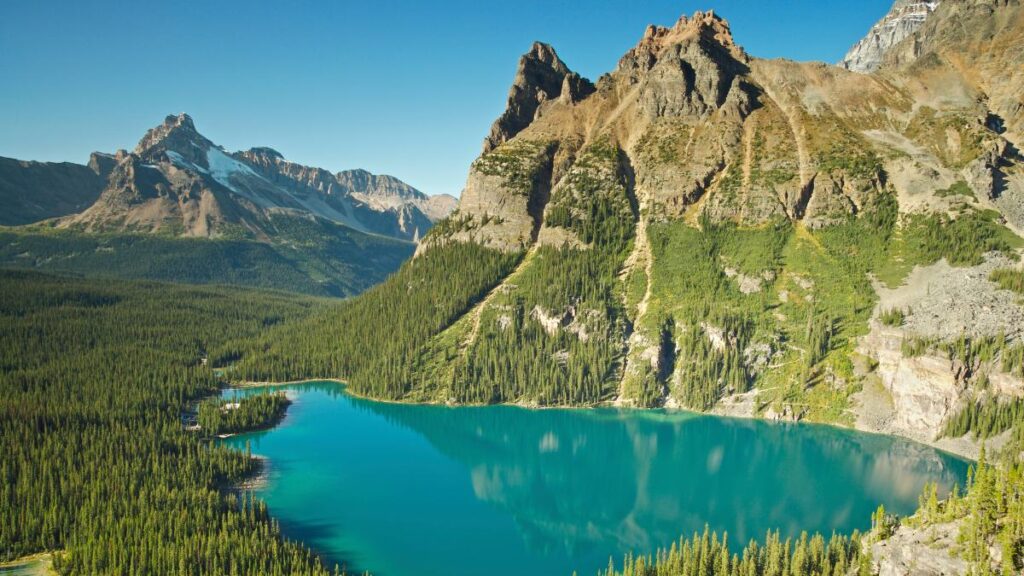
Distance: 11 km (6.8 miles) loop
Elevation Gain: 900 m (2,953 ft)
Time: 5 to 7 hours
Difficulty: Challenging
The Alpine Circuit is the crown jewel of Lake O’Hara hiking. It is an adventurous loop with four interconnected alpine routes: Wiwaxy Gap, Huber Ledges, Yukness Ledges, and the All Souls Prospect.
Each section offers jaw-dropping views, airy ledges, and high-alpine exposure. It’s not for beginners, but if you’re confident with heights and footing, it’s one of the best hikes in the Canadian Rockies.
Many hikers tackle it counterclockwise, starting with a tough climb to Wiwaxy Gap. Take your time, pack plenty of water, and give yourself the day because this one’s an unforgettable adventure.
6. Linda Lake & Morning Glory Lakes

Distance: 7 km (4.3 miles) return
Elevation Gain: 140 m (459 ft)
Time: 2 to 2.5 hours
Difficulty: Easy to Moderate
This mellow trail winds through peaceful forest and open meadows to some spectcular tucked-away alpine lakes, Linda Lake and the Morning Glory Lakes. It’s less popular than other hikes, making it a great option if you’re craving solitude.
You’ll cross creeks, pass wildflower-studded hillsides, and enjoy frequent bird sightings. In late summer, the area is lush and quiet, with reflections of surrounding ridges dancing on the lake surfaces.
It’s a great out-and-back for a half-day wander. The gentle terrain and low traffic make this trail perfect for a relaxed pace or mindful nature walk.
7. Duchesnay Basin Trail
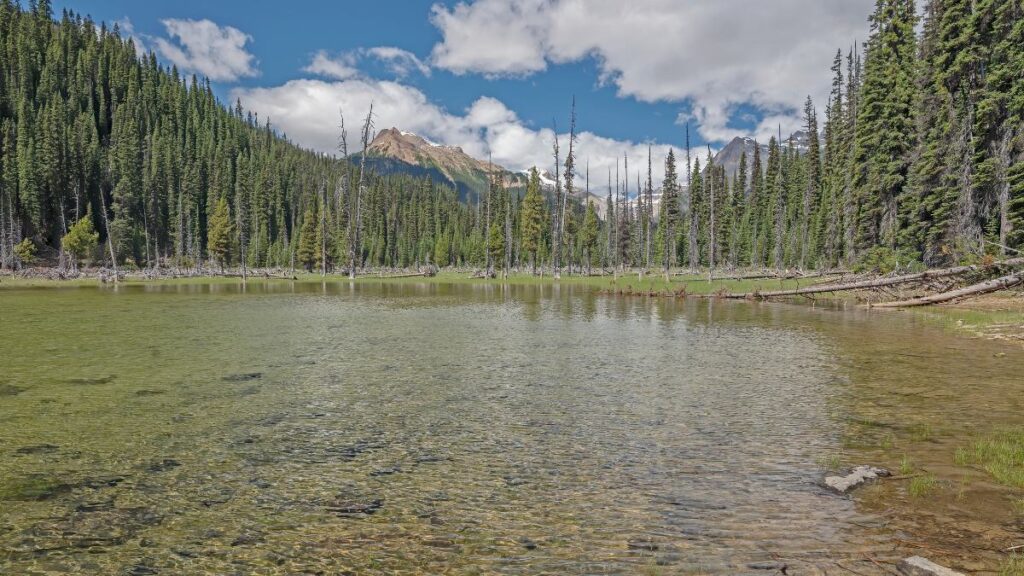
Distance: 6.4 km (4 miles) return
Elevation Gain: 230 m (755 ft)
Time: 2 to 3 hours
Difficulty: Moderate
This trail picks up where the Linda Lake trail ends, continuing deeper into alpine meadows and the Duchesnay Basin. It’s quiet, wild, and offers an unfiltered slice of Yoho National Park’s glacier-carved terrain.
As you ascend, the views open up dramatically. You’ll pass kettle ponds, glacial boulders, and get stunning perspectives of Cathedral Mountain. The trail ends near the base of the Duchesnay Icefield.
Fewer hikers venture this far, so the area feels untouched. It’s one of those trails that rewards curiosity and a love for exploring lesser-known corners.
8. Odaray Highline Trail to Odaray Grandview
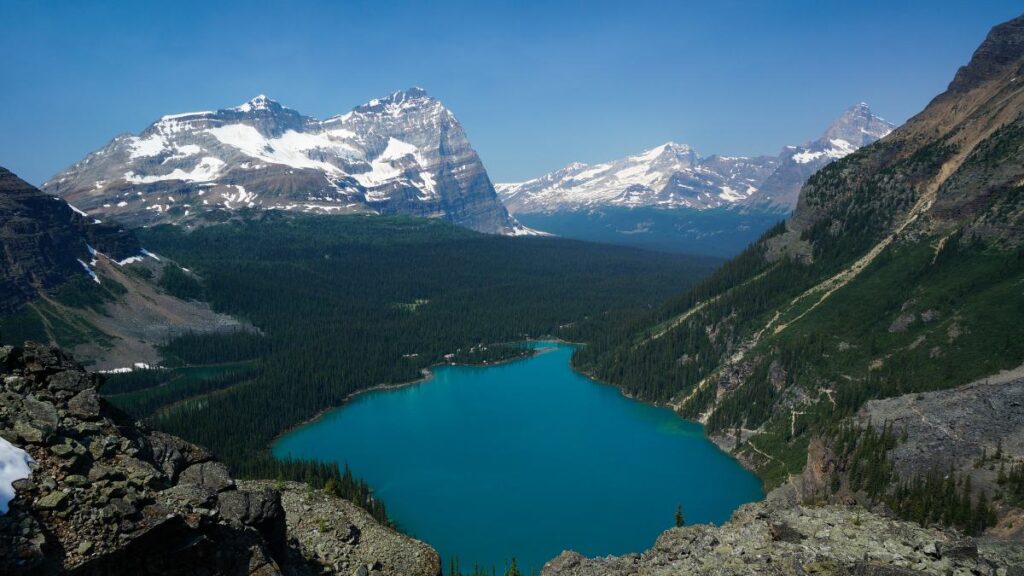
Distance: 2.4 km (1.5 miles) out and back
Elevation Gain: 90 m (295 ft)
Time: 1.5 to 2 hours
Difficulty: Moderate (restricted access)
This short but steep climb leads to a viewpoint with panoramic glory: Odaray Grandview. It looks out over the full Lake O’Hara valley, with Mount Victoria and the Continental Divide stealing the show.
The trail has a quota system to protect wildlife corridors, so check with Parks Canada before hiking. It may be restricted to a few hikers per day. If you get access, it’s totally worth the detour.
It’s a great add-on to a morning hike like McArthur or Linda Lake. Just know the hiking trail is narrow and exposed in spots, so good footing and balance are key.
9. All Souls Prospect
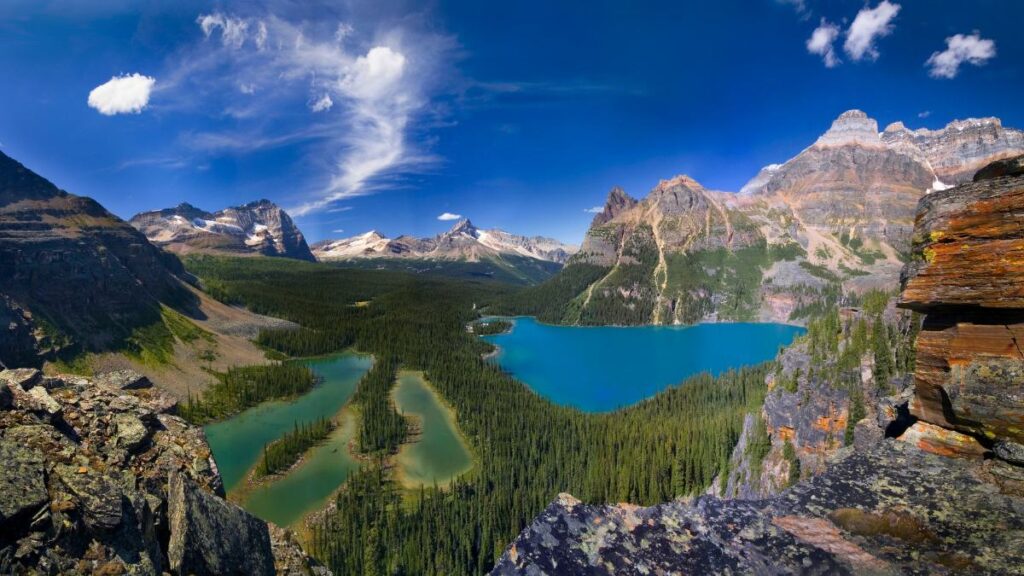
Distance: 7 km (4.3 miles) return
Elevation Gain: 400 m (1,312 ft)
Time: 3 to 5 hours
Difficulty: Challenging
If you want the best lookout in the park, this is the one. All Souls Prospect sits high above Lake O’Hara, with 360° views of Mary Lake, Opabin Plateau, and the Alpine Circuit ridges.
To reach it, you’ll hike up steep switchbacks from either Opabin or Lake Oesa, depending on your route. The trail is exposed, so it’s best done on a clear, dry day with proper gear.
This is a “take-your-breath-away” kind of spot… not just from the climb, but from the extraordinary views. This hike is perfect for experienced hikers who want to go big without committing to the full Alpine Circuit.
10. Yukness Ledges Alpine Route
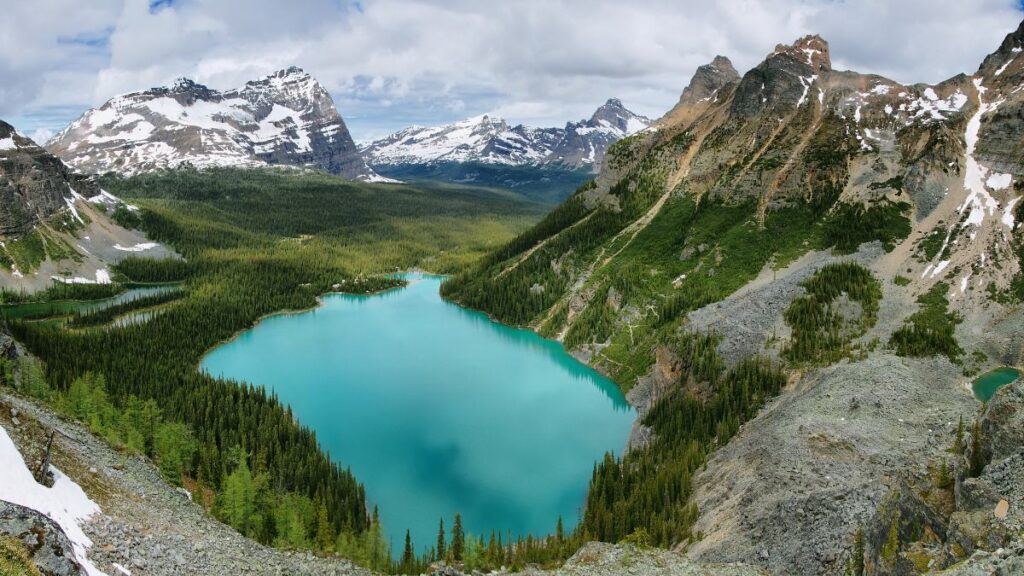
Distance: 2.2 km (1.4 miles) one-way
Elevation Gain: 150 m (492 ft)
Time: 1.5 to 2 hours (one-way)
Difficulty: Difficult (Alpine route)
This exposed alpine route connects Lake Oesa to Opabin Plateau, skirting along the cliffs of Yukness Mountain. It’s part of the Alpine Circuit, and it is not for the faint of heart.
You’ll traverse narrow ledges with nothing but mountain air to your side. A helmet is recommended in icy or wet conditions. The hiking route requires careful footing and a good sense of adventure.
It’s a thrilling way to link up two iconic trails while soaking in ridiculous views over Lake O’Hara and the surrounding peaks of the Canadian Rockies. If you’re steady on your feet and up for something gnarly, this one’s unforgettable.
Explore The Natural Wonders of Lake O’Hara
If you don’t win the shuttle lottery or can’t score a spot at Lake O’Hara Lodge, don’t write the trip off just yet. You still have options.
Hiking the 11 km access road is always possible if you’re up for the climb. But if you want a smoother experience, hiring a certified Lake O’Hara hiking guide can significantly improve your experience and help you reserve some spots on the national park shuttle bus to Lake O’Hara.
Some guides have access to reserved shuttle spots. Even if they don’t, they can help you make the most of your visit to Banff and Yoho National Parks with things such as planning your route, sharing local knowledge and guiding you safely through high-elevation terrain.
If Lake O’Hara is on your bucket list (and it should be), having a local in your corner can be the key to unlocking the natural wonders of this magical place in the Canadian Rockies.
- 10 Best Multi-Day Hikes In Banff And The Canadian Rockies - April 18, 2025
- The 10 Best Hikes At Lake O’Hara In Yoho National Park - April 18, 2025
- The 10 Best Hikes In Banff National Park For Summit Views - April 18, 2025

